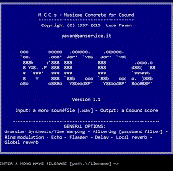DOS PROGRAMS:
:_________
:_________
MUSIC:
:_________
:_________
MCCs - Musique Concrète for Csound
Software for music composition with Csound
Version 3.5
Windows command prompt

===
MCCs - MUSIQUE CONCRÈTE for Csound ===
Version 3.5
A Csound Score Generator for Windows Command Prompt
SOFTWARE FOR MUSIC COMPOSITION WITH CSOUND
(C) Copyright 1997-2021 Luca Pavan
SOME FEATURES OF VERSION 3.5
-Language: English
-OS: Microsoft Windows (it runs in Windows Command prompt).
-It does not require the knowledge of Csound language.
-Input is a mono soundfile (.wav) and output a stereo soundfile.
-It is possible to compose whole pieces of music with Csound.
-Unlimited number of notes in the score.
-Sound synthesis includes: grains, time warping, filtering, ring
modulation, echo, flanger, delay, local reverberation, global
reverberation.
-It can generate tonal or microtonal music.
-It allows to change the input soundfile in the same score.
-It allows to create rythmic loops (also with random patterns).
-It generates scores which work with Csound from version 4.19.
-It allows to have randomized parameters or ramps with interpolation.
-It generates a log file with all the score settings.
INTRODUCTION
Csound, developed by Barry Vercoe and others at the Massachussets
Institute of Technology (Boston, MA), is one of the most popular
programs for sound synthesis, used by many composers and researchers in
the world. Csound is a free software and can be downloaded on the
Internet.
Musique concrete (concrete music) is a term invented by the French
composer Pierre Schaeffer in the first half of 20th century, to define a
kind of music done with recorded sounds coming from the "real world".
These recordings were subjected to various manipulations, to create
sound materials for musical works. Musique concrete, at the beginning,
was realized with analogic equipment (in the early 1950s the tape
recorder was adopted in this field) and the main techniques to make this
music were cut and splicing, change of tape speed, tape delay,
tape loops etc. In USA this kind of music was called "tape music".
With the evolution of new technologies these techniques are today
available with digital equipments. Csound achieves the same results that
Schaeffer obtained in his studio with the manipulation of analogic
tapes, and much more. Csound works by a digital process and in this way
the opportunities of sound manipulation are strongly increased.
MCCs comes from the idea to help composers working with informatic
technologies. The goal of MCCs is the generation of scores that work
with digital recorded sounds. The composer can interact with a simple
interface, assigning the parameters to the composition; he has the
opportunity to use some Csound capabilities without knowing Csound
itself. The program automatically generates the orchestra file and the
score file. Later these files can be processed with Csound. The composer
can select among several options: granular synthesis of the input
soundfile, time warping, filtering (with a 2nd order passband
filter), ring modulation, echo, flanger, delay, local reverb and global
reverb. These sound manipulations can be carried out separately or
contemporarily.
There are various default options and the possibility to assign aleatory
values to many parameters.
HOW TO USE MCCs
MCCs (originally written in Borland Pascal 7.0, now in Borland
C++)generates text format scores [.sco] for Csound synthesis. MCCs
generates, with the score, also an orchestra file [.orc]. To obtain a
processed score Csound is required in your Hard Disk.
MCCs accepts as input mono soundfiles [.wav]. You have to answer
several questions to set the parameters of the score. Some general
options are possible, one by one or simultaneously (in this case the
time for synthesis is longer). The file you get after the synthesis will
be a stereo soundfile.
Near each question a unity of measurement is specified in square
brackets, like this:
[Hz] = Hertz
[s] = seconds
[ms] = milliseconds
To use this program is good to have some knowledge of sound synthesis
techniques, or the results could be different from what the user
expects. It is better to know what is a flanger or a delay, and the
difference between local reverberation and global reverberation for a
good sound spatialization.
If someone needs to have a basic knowledge about these techniques,
I suggest to read this:
C. Dodge & T. A. Jerse, "Computer Music - Synthesis,
Composition, and Performance", Schirmer Books, 1985, New York.
Examples of music generated with MCCs:
Strade - excerpt (mp3, 44100 Hz)
Strade - excerpt 2 (mp3, 44100 Hz)
Voices - excerpt (mp3, 44100 Hz)
Percezioni - excerpt (mp3, 44100 Hz)
La fonte - excerpt (mp3, 44100 Hz)
L'inesattezza - excerpt (mp3, 44100 Hz)
Sky Pigs - excerpt (mp3, 44100 Hz)
L'abisso - excerpt (mp3, 44100 Hz)
Pulses - excerpt (mp3, 44100 Hz)
The blue monkey (oriental theme) - excerpt (mp3, 44100 Hz)
The next file is mono and made with filtered noise. It was created with the same technique (generative with random loops). It lasts about 5 and a half hours and should be used by people who have troubles falling asleep. The tempo is synchronized with the human heartbeat, which is less frequent as the night goes by. The amplitude drops slowly (however I would not recommend to play the file loudly). The file could also be played by a mobile phone, keeping the volume low.
© 2025 Luca Pavan